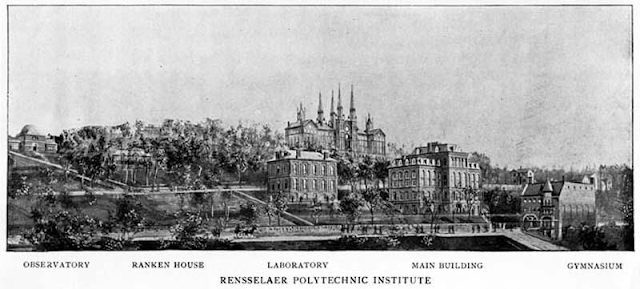Did you ever hear of The Troy University? I hadn’t until Automation Archivist Tammy Gobert ’08 told me about it and offered to assemble a display of materials about the university that were uncovered in a tin box taken from the cornerstone of the building. The cornerstone was unearthed when the building that was once The Troy University was torn down in 1969 and its contents donated to the Institute.
Tammy has three cases filled with rare photographs, documents, a handsomely handwritten manuscript describing the formation of The Troy University, and a wood baluster retrieved from a circular staircase in one of university’s towers. The exhibit will be on display until the end of the year. If you plan to be on campus for Reunion & Homecoming 2011, why not stop by the Folsom Library (which, incidentally is erected on the very site where The Troy University sat) and check out Tammy’s exhibit.
In the event you’re not able to visit the library to see the display, here’s a bit of history about The Troy University and what followed it:
Construction of the imposing four-story Byzantine-style structure with four stately spires and two towers began in 1856. The university opened as a non-denominational Christian college run by the Methodist Episcopal Church in 1858 but had to close after only four years due to financial problems. One class did graduate.
The photo below is from a picture postcard from 1896. The majestic building sits atop the hill with the RPI campus in the foreground. Here all four spires are still intact. It was unfortunate that lightning strikes either completely destroyed or damaged the spires over the years. I’m told it was at one time the largest building in Troy.
About a year after The Troy University closed, the building and surrounding grounds were purchased by the Catholic Church and used to house St. Joseph’s Seminary until the 1890s.
In 1908, the Sisters of St. Joseph of Carondelet bought the building and established a convent and novitiate there four years later. For a period of time, the building (still called St. Joseph’s Seminary) also housed a chapel, but in 1930 the nuns decided to build a separate building of worship. The splendid St. Joseph’s Chapel was built across from the seminary. A connecting structure was added to link the two buildings. You can see it in the photo below.
In the 1950s, the sisters decided to consolidate and move their center of operations to another location. They sold the entire estate in 1958 to the Institute.
St. Joseph’s Seminary was renamed University Building, and RPI used it for classes and administration offices. St. Joseph’s Chapel was deconsecrated and found another use as RPI’s library from 1960 to 1976. Over time, The University Building deteriorated and was demolished in 1969. When the library outgrew its space in the old chapel, the former location of the University Building was one of the spots considered and finally selected for a “fine new library.” The Richard G. Folsom Library was erected and opened in 1976. Ultimately, it was decided to renovate the now empty chapel into a new computing center, and the Alan M. Voorhees Computing Center (a.k.a. VCC) opened in 1979.
Thinking of the VCC before its reincarnation (pun intended) reminds me of something. Before I started working in the library, I worked in the VCC for 17 years. My office on the second floor was built over what was once the chapel’s main altar. Of course, when the chapel was converted into a secular building, most reminders of its former function were removed and the walls, many of which had saints or religious symbols painted on them, were whitewashed. (I was told that the stained-glass windows weren’t removed because it was deemed unsafe to tamper with them because of the high lead content.) However, the dozen or so saints that were so intricately painted on the celling of the chapel weren’t eliminated because the renovation was going to end with the second floor and the space above that was going to be off limits unless someone climbed a ladder and entered that level through one of two trapdoors. For me, it was always a thrill when an electrician or other worker asked for access to the top level. While he was occupied getting a ladder, I would be busy notifying the building staff that here was a rare opportunity for them to come see the saints. I used to tell folks that I felt blessed to have the saints looking down on me.
I wish the photo above, taken from the souvenir book the sisters had produced when their chapel was dedicated, were in color.
Adrienne Birchler
Coordinator
Friends of the Folsom Library







